Sports Management Report: Transformational Leadership Analysis
VerifiedAdded on 2023/06/04
|7
|1127
|56
Report
AI Summary
This report provides an overview of sports management, focusing on the concept of transformational leadership. It begins by explaining the theory of transformational leadership, highlighting its role in fostering positive change within individuals and social systems. The report delves into the historical context of transformational leadership, tracing its origins to James McGregor Burns's work on political leaders and later developments by Bernard M. Bass. It explores how transformational leaders inspire and motivate followers through intellectual stimulation, idealized influence, inspirational motivation, and individualized consideration. The report emphasizes the leader's role as a role model and the importance of aligning followers with tasks that optimize their performance. This report aims to provide a comprehensive understanding of transformational leadership within the context of sports management, discussing its evolution, key components, and practical applications.

Running head: SPORTS MANAGEMENT
Sports Management
Name of the Student:
Name of the University:
Author Note:
Sports Management
Name of the Student:
Name of the University:
Author Note:
Paraphrase This Document
Need a fresh take? Get an instant paraphrase of this document with our AI Paraphraser

1SPORTS MANAGEMENT
Executive Summary:
The report gives an overview of sports management by putting forward an explanation of
transformational leadership. The report commences with how the theory of the transformational
leader was made. The report also puts forward a brief history of the transformational leadership.
Executive Summary:
The report gives an overview of sports management by putting forward an explanation of
transformational leadership. The report commences with how the theory of the transformational
leader was made. The report also puts forward a brief history of the transformational leadership.
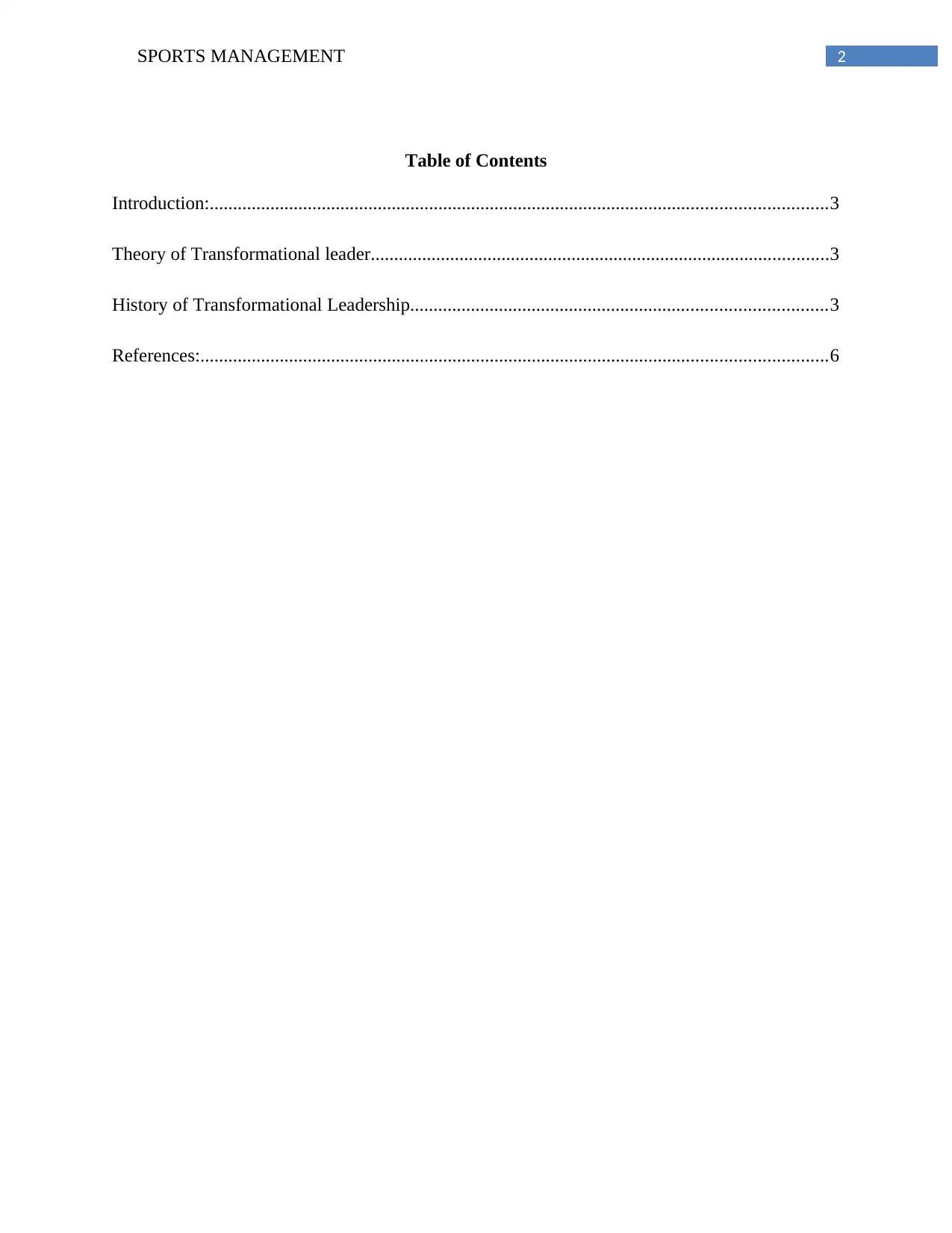
2SPORTS MANAGEMENT
Table of Contents
Introduction:....................................................................................................................................3
Theory of Transformational leader..................................................................................................3
History of Transformational Leadership.........................................................................................3
References:......................................................................................................................................6
Table of Contents
Introduction:....................................................................................................................................3
Theory of Transformational leader..................................................................................................3
History of Transformational Leadership.........................................................................................3
References:......................................................................................................................................6
⊘ This is a preview!⊘
Do you want full access?
Subscribe today to unlock all pages.

Trusted by 1+ million students worldwide
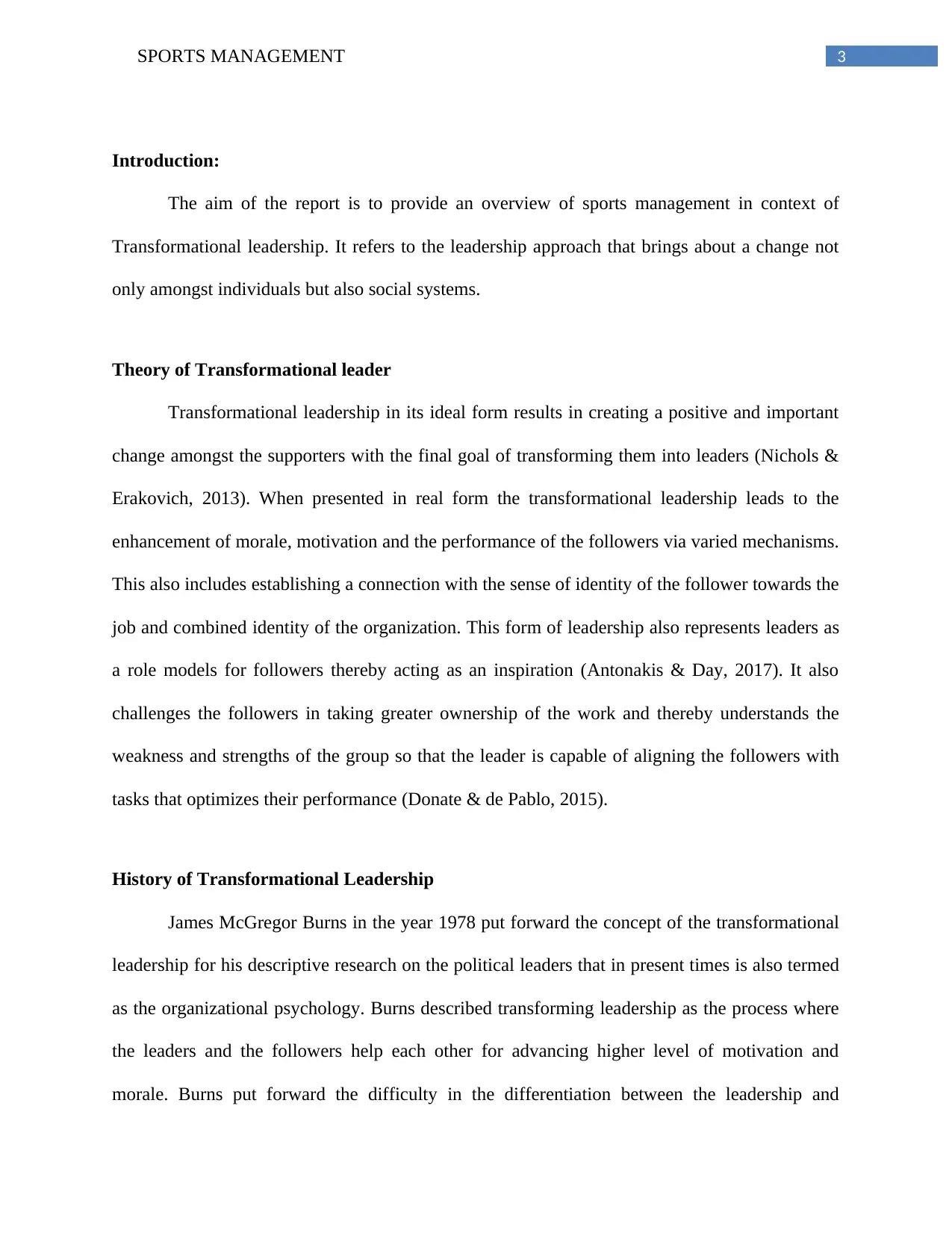
3SPORTS MANAGEMENT
Introduction:
The aim of the report is to provide an overview of sports management in context of
Transformational leadership. It refers to the leadership approach that brings about a change not
only amongst individuals but also social systems.
Theory of Transformational leader
Transformational leadership in its ideal form results in creating a positive and important
change amongst the supporters with the final goal of transforming them into leaders (Nichols &
Erakovich, 2013). When presented in real form the transformational leadership leads to the
enhancement of morale, motivation and the performance of the followers via varied mechanisms.
This also includes establishing a connection with the sense of identity of the follower towards the
job and combined identity of the organization. This form of leadership also represents leaders as
a role models for followers thereby acting as an inspiration (Antonakis & Day, 2017). It also
challenges the followers in taking greater ownership of the work and thereby understands the
weakness and strengths of the group so that the leader is capable of aligning the followers with
tasks that optimizes their performance (Donate & de Pablo, 2015).
History of Transformational Leadership
James McGregor Burns in the year 1978 put forward the concept of the transformational
leadership for his descriptive research on the political leaders that in present times is also termed
as the organizational psychology. Burns described transforming leadership as the process where
the leaders and the followers help each other for advancing higher level of motivation and
morale. Burns put forward the difficulty in the differentiation between the leadership and
Introduction:
The aim of the report is to provide an overview of sports management in context of
Transformational leadership. It refers to the leadership approach that brings about a change not
only amongst individuals but also social systems.
Theory of Transformational leader
Transformational leadership in its ideal form results in creating a positive and important
change amongst the supporters with the final goal of transforming them into leaders (Nichols &
Erakovich, 2013). When presented in real form the transformational leadership leads to the
enhancement of morale, motivation and the performance of the followers via varied mechanisms.
This also includes establishing a connection with the sense of identity of the follower towards the
job and combined identity of the organization. This form of leadership also represents leaders as
a role models for followers thereby acting as an inspiration (Antonakis & Day, 2017). It also
challenges the followers in taking greater ownership of the work and thereby understands the
weakness and strengths of the group so that the leader is capable of aligning the followers with
tasks that optimizes their performance (Donate & de Pablo, 2015).
History of Transformational Leadership
James McGregor Burns in the year 1978 put forward the concept of the transformational
leadership for his descriptive research on the political leaders that in present times is also termed
as the organizational psychology. Burns described transforming leadership as the process where
the leaders and the followers help each other for advancing higher level of motivation and
morale. Burns put forward the difficulty in the differentiation between the leadership and
Paraphrase This Document
Need a fresh take? Get an instant paraphrase of this document with our AI Paraphraser
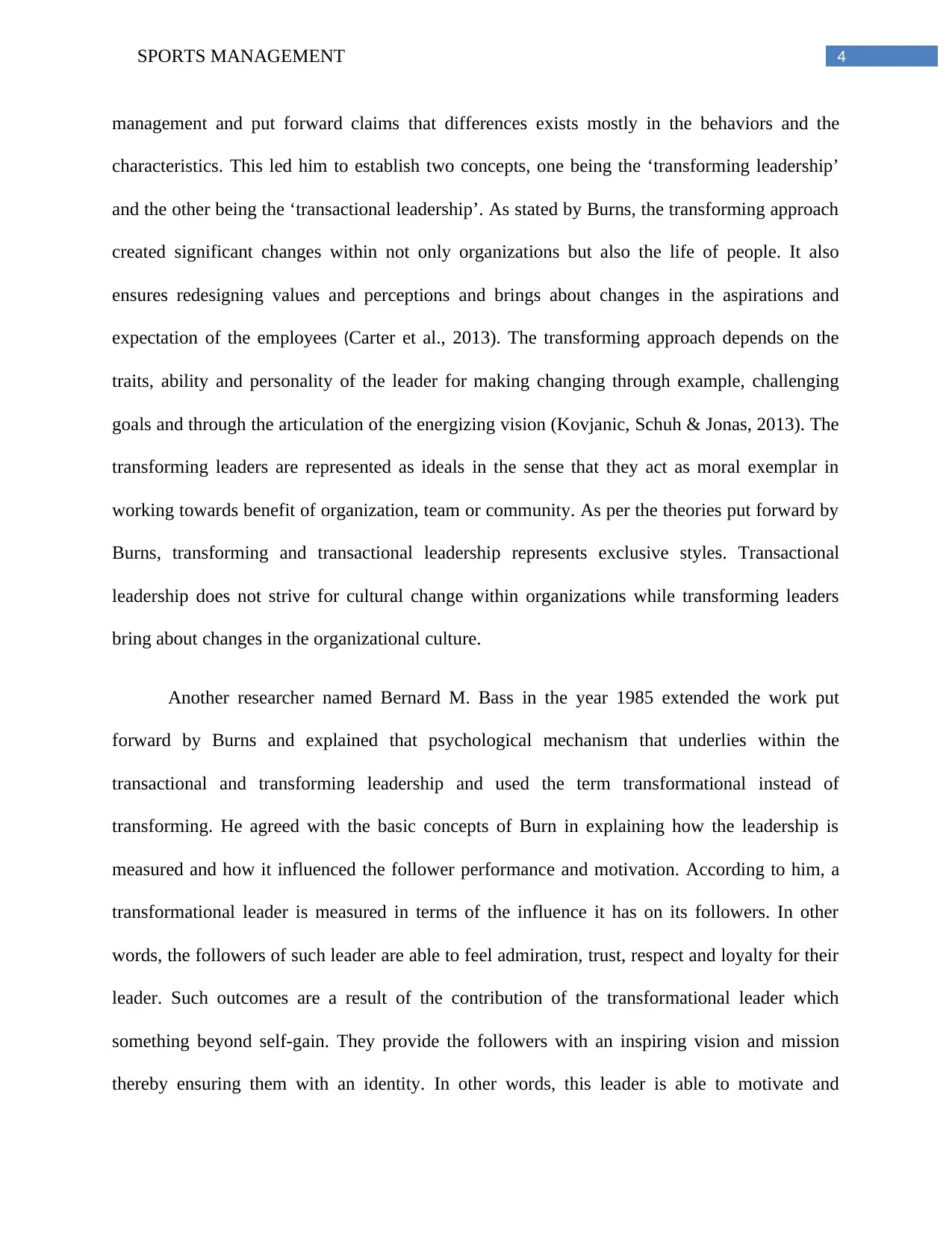
4SPORTS MANAGEMENT
management and put forward claims that differences exists mostly in the behaviors and the
characteristics. This led him to establish two concepts, one being the ‘transforming leadership’
and the other being the ‘transactional leadership’. As stated by Burns, the transforming approach
created significant changes within not only organizations but also the life of people. It also
ensures redesigning values and perceptions and brings about changes in the aspirations and
expectation of the employees (Carter et al., 2013). The transforming approach depends on the
traits, ability and personality of the leader for making changing through example, challenging
goals and through the articulation of the energizing vision (Kovjanic, Schuh & Jonas, 2013). The
transforming leaders are represented as ideals in the sense that they act as moral exemplar in
working towards benefit of organization, team or community. As per the theories put forward by
Burns, transforming and transactional leadership represents exclusive styles. Transactional
leadership does not strive for cultural change within organizations while transforming leaders
bring about changes in the organizational culture.
Another researcher named Bernard M. Bass in the year 1985 extended the work put
forward by Burns and explained that psychological mechanism that underlies within the
transactional and transforming leadership and used the term transformational instead of
transforming. He agreed with the basic concepts of Burn in explaining how the leadership is
measured and how it influenced the follower performance and motivation. According to him, a
transformational leader is measured in terms of the influence it has on its followers. In other
words, the followers of such leader are able to feel admiration, trust, respect and loyalty for their
leader. Such outcomes are a result of the contribution of the transformational leader which
something beyond self-gain. They provide the followers with an inspiring vision and mission
thereby ensuring them with an identity. In other words, this leader is able to motivate and
management and put forward claims that differences exists mostly in the behaviors and the
characteristics. This led him to establish two concepts, one being the ‘transforming leadership’
and the other being the ‘transactional leadership’. As stated by Burns, the transforming approach
created significant changes within not only organizations but also the life of people. It also
ensures redesigning values and perceptions and brings about changes in the aspirations and
expectation of the employees (Carter et al., 2013). The transforming approach depends on the
traits, ability and personality of the leader for making changing through example, challenging
goals and through the articulation of the energizing vision (Kovjanic, Schuh & Jonas, 2013). The
transforming leaders are represented as ideals in the sense that they act as moral exemplar in
working towards benefit of organization, team or community. As per the theories put forward by
Burns, transforming and transactional leadership represents exclusive styles. Transactional
leadership does not strive for cultural change within organizations while transforming leaders
bring about changes in the organizational culture.
Another researcher named Bernard M. Bass in the year 1985 extended the work put
forward by Burns and explained that psychological mechanism that underlies within the
transactional and transforming leadership and used the term transformational instead of
transforming. He agreed with the basic concepts of Burn in explaining how the leadership is
measured and how it influenced the follower performance and motivation. According to him, a
transformational leader is measured in terms of the influence it has on its followers. In other
words, the followers of such leader are able to feel admiration, trust, respect and loyalty for their
leader. Such outcomes are a result of the contribution of the transformational leader which
something beyond self-gain. They provide the followers with an inspiring vision and mission
thereby ensuring them with an identity. In other words, this leader is able to motivate and
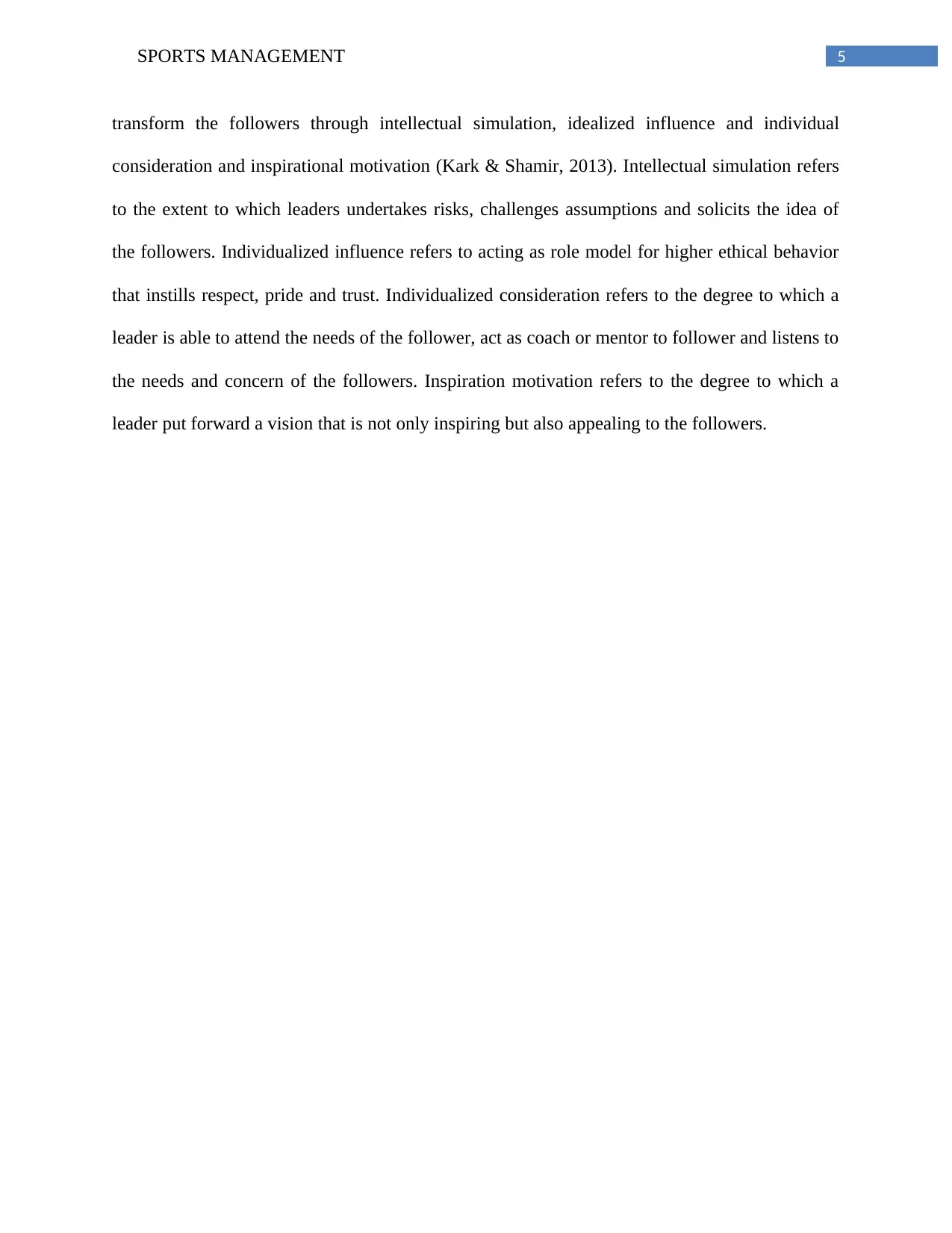
5SPORTS MANAGEMENT
transform the followers through intellectual simulation, idealized influence and individual
consideration and inspirational motivation (Kark & Shamir, 2013). Intellectual simulation refers
to the extent to which leaders undertakes risks, challenges assumptions and solicits the idea of
the followers. Individualized influence refers to acting as role model for higher ethical behavior
that instills respect, pride and trust. Individualized consideration refers to the degree to which a
leader is able to attend the needs of the follower, act as coach or mentor to follower and listens to
the needs and concern of the followers. Inspiration motivation refers to the degree to which a
leader put forward a vision that is not only inspiring but also appealing to the followers.
transform the followers through intellectual simulation, idealized influence and individual
consideration and inspirational motivation (Kark & Shamir, 2013). Intellectual simulation refers
to the extent to which leaders undertakes risks, challenges assumptions and solicits the idea of
the followers. Individualized influence refers to acting as role model for higher ethical behavior
that instills respect, pride and trust. Individualized consideration refers to the degree to which a
leader is able to attend the needs of the follower, act as coach or mentor to follower and listens to
the needs and concern of the followers. Inspiration motivation refers to the degree to which a
leader put forward a vision that is not only inspiring but also appealing to the followers.
⊘ This is a preview!⊘
Do you want full access?
Subscribe today to unlock all pages.

Trusted by 1+ million students worldwide
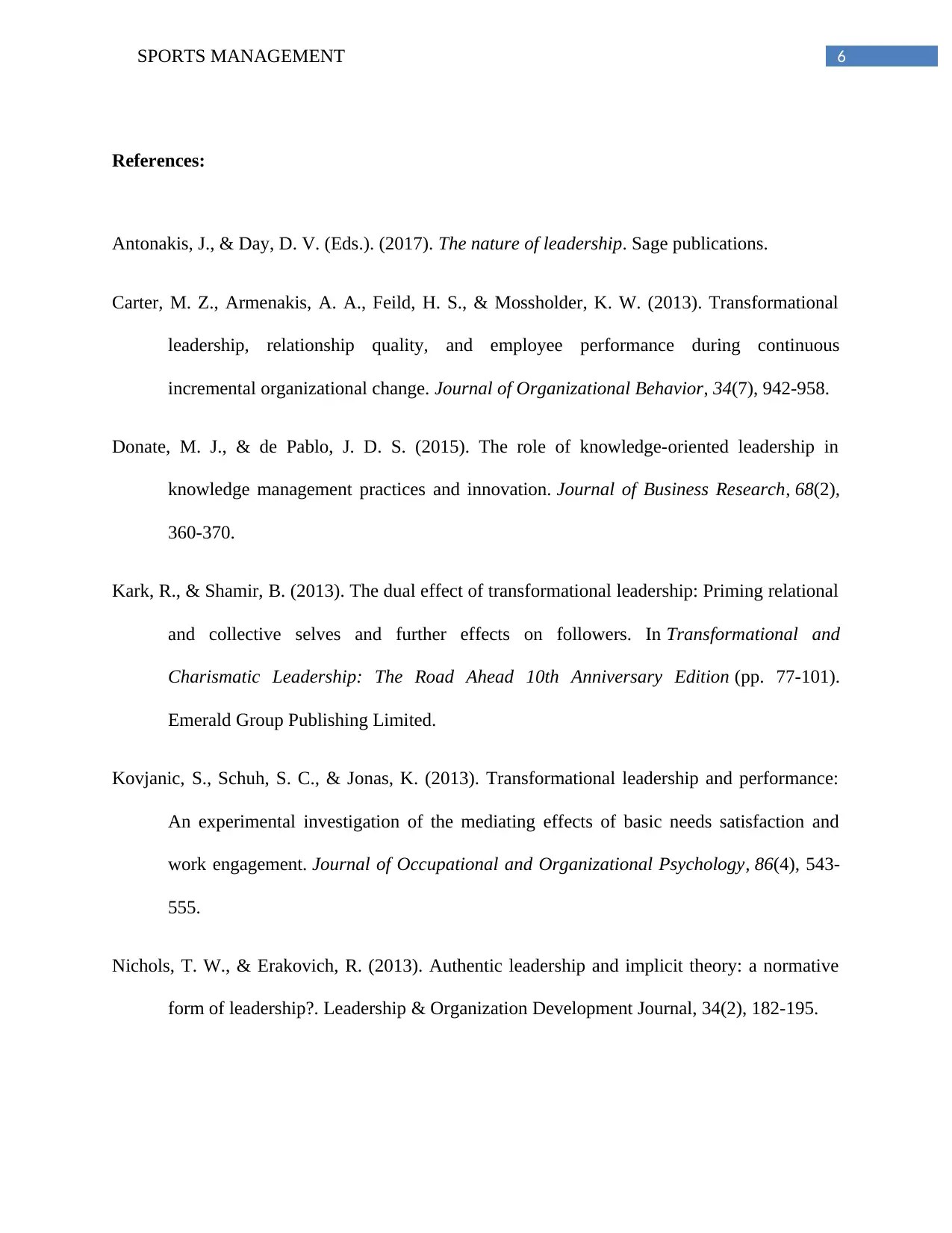
6SPORTS MANAGEMENT
References:
Antonakis, J., & Day, D. V. (Eds.). (2017). The nature of leadership. Sage publications.
Carter, M. Z., Armenakis, A. A., Feild, H. S., & Mossholder, K. W. (2013). Transformational
leadership, relationship quality, and employee performance during continuous
incremental organizational change. Journal of Organizational Behavior, 34(7), 942-958.
Donate, M. J., & de Pablo, J. D. S. (2015). The role of knowledge-oriented leadership in
knowledge management practices and innovation. Journal of Business Research, 68(2),
360-370.
Kark, R., & Shamir, B. (2013). The dual effect of transformational leadership: Priming relational
and collective selves and further effects on followers. In Transformational and
Charismatic Leadership: The Road Ahead 10th Anniversary Edition (pp. 77-101).
Emerald Group Publishing Limited.
Kovjanic, S., Schuh, S. C., & Jonas, K. (2013). Transformational leadership and performance:
An experimental investigation of the mediating effects of basic needs satisfaction and
work engagement. Journal of Occupational and Organizational Psychology, 86(4), 543-
555.
Nichols, T. W., & Erakovich, R. (2013). Authentic leadership and implicit theory: a normative
form of leadership?. Leadership & Organization Development Journal, 34(2), 182-195.
References:
Antonakis, J., & Day, D. V. (Eds.). (2017). The nature of leadership. Sage publications.
Carter, M. Z., Armenakis, A. A., Feild, H. S., & Mossholder, K. W. (2013). Transformational
leadership, relationship quality, and employee performance during continuous
incremental organizational change. Journal of Organizational Behavior, 34(7), 942-958.
Donate, M. J., & de Pablo, J. D. S. (2015). The role of knowledge-oriented leadership in
knowledge management practices and innovation. Journal of Business Research, 68(2),
360-370.
Kark, R., & Shamir, B. (2013). The dual effect of transformational leadership: Priming relational
and collective selves and further effects on followers. In Transformational and
Charismatic Leadership: The Road Ahead 10th Anniversary Edition (pp. 77-101).
Emerald Group Publishing Limited.
Kovjanic, S., Schuh, S. C., & Jonas, K. (2013). Transformational leadership and performance:
An experimental investigation of the mediating effects of basic needs satisfaction and
work engagement. Journal of Occupational and Organizational Psychology, 86(4), 543-
555.
Nichols, T. W., & Erakovich, R. (2013). Authentic leadership and implicit theory: a normative
form of leadership?. Leadership & Organization Development Journal, 34(2), 182-195.
1 out of 7
Related Documents
Your All-in-One AI-Powered Toolkit for Academic Success.
+13062052269
info@desklib.com
Available 24*7 on WhatsApp / Email
![[object Object]](/_next/static/media/star-bottom.7253800d.svg)
Unlock your academic potential
Copyright © 2020–2025 A2Z Services. All Rights Reserved. Developed and managed by ZUCOL.


